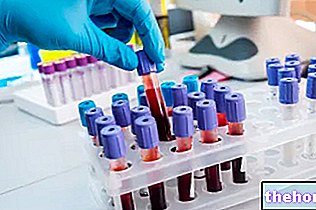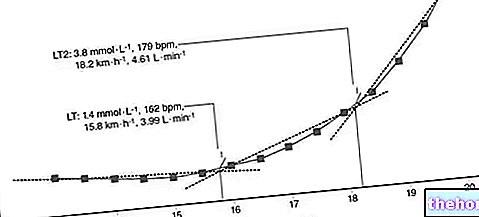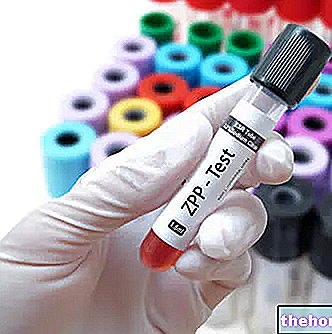
Also called protein electrophoresis or protidogram, this test is carried out by adopting a very particular method: an electric field is applied to the sample, thanks to which the proteins are "grouped" by type. Each of the proteins allows to analyze the electrophoresis. , has its own molecular mass and electric charge, which allows them to respond to the stress provided by direct current in a characteristic way. Under normal conditions, for example, the first expected peak - higher and narrower - in the electrophoretic trace corresponds to albumin.
In more practical terms, "electrophoresis is an" analysis used to determine:
- The presence of abnormal proteins;
- The absence of normal proteins;
- Whether a group of proteins is present in lesser or greater quantities than normal.
Electrophoresis can be requested by the doctor as part of the control tests (routine analysis) or of the diagnostic process, ie in the event that other laboratory tests have shown alterations and it is necessary to investigate or confirm a clinical suspicion.
, spinal cord, cranial nerves and spinal roots).Electrophoresis: what is measured
Plasma proteins are very important indicators: any alterations in their concentrations can signal the presence of numerous diseases.
With electrophoresis it is possible to separate the following proteins in the sample:
- L "albumin;
- The alpha 1 globulins;
- The alpha 2 globulins;
- The beta globulins;
- The gamma globulins.
At present, many laboratories carry out a separation in 6 bands, that is, with the separation of beta globulins into two fractions:
- Beta 1 globulins;
- Beta 2 globulins.
Did you know that…
In the laboratory, electrophoresis is one of the most widely used techniques to analyze the qualitative and quantitative composition of proteins. This separation method is based on the different speed of migration of electrically charged particles, through a solution and a support medium, under the " influence of an electric field.
Albumin is the most abundant protein in whey and one of the most important in the body. This is synthesized by the liver and is mainly contained in interstitial fluids and plasma, where it alone accounts for about half of the circulating proteins. Albumin performs various functions, including the correct management of osmotic pressure and the transport of substances, such as bilirubin.
The alpha globulins 1 and 2 mainly carry out a transport function of lipids, blood fats and hormones. Beta globulins also carry substances present in the blood; among the best known proteins of this group are transferrin (responsible for transporting iron) and beta-2 microglobulin. Gamma globulins, on the other hand, have mainly an antibody function.
Some plasma proteins are produced by the liver (such as albumin), while others are released into the blood by cells belonging to the immune system (gamma globulins).
To know more: Plasma Proteins - Functions and CharacteristicsElectrophoresis: basic principle
Introduction: in general, electrophoresis is a separation method based on the different migration speed of electrically charged particles, through a solution and a porous and inert support medium (such as paper, agarose gel or cellulose acetate sheet), under the impulse of an electric field. Many molecules of biological interest (amino acids, peptides, proteins, DNA and RNA) possess ionizable groups in their structure, therefore, at a suitable pH value, these are present in solution as electrically charged species. Under the influence of an electric field these charged molecules migrate towards the cathode or the anode, depending on whether they have a positive charge (cations) or negative (anions).
Electrophoresis is a method that allows to separate macromolecules and, in particular, proteins on the basis of their:
- Molecular mass;
- Electric charge.
When placed in a basic environment, proteins behave like acids: the COOH group of the various amino acids that make up the structure of the macromolecule, dissociates into COO– (negative particle) and H + (positive ion). The proteins are therefore charged overall in a negative direction and their electrophoretic mobility goes from the negative pole (cathode) to the positive one, that is towards the anode (since the negative charges exceed the positive ones).
Returning to the examination, the patient's sample - containing a mixture of proteins (eg serum proteins) - is placed on an electrophoretic strip, ie the migration support.
The separation into five bands is obtained through the application of an electric field, generated by a direct current, which allows the different protein fractions to migrate according to their mass and their electric charge.

The result - called ELECTROPHORETIC TRACE - consists of various peaks and curves, which correspond to the protein fractions, divided by type and quantity, present in the liquid under examination:
- Normally, the first peak, higher and narrower, is that of the ALBUMINA;
- Following, the peaks of GLOBULINS are observed, much lower than albumin.
The increase or decrease in amplitude and intensity of the peaks that form in the trace indicate a greater or lesser presence of the proteins of each category.
Did you know that…
In the past, transthyretin was defined as prealbumin due to its greater electrophoretic mobility compared to albumin, which allows it to migrate to a more anodic position.
For further information: Prealbumin - What it is ;Electrophoresis: when is the examination prescribed?
INTRODUCTION: the measurement of total proteins in the blood - proteinmia - and of albumin - albuminemia - is usually included in the control panels, therefore it is frequently used in the evaluation of the state of health of a person. In routine analyzes, the alteration of these parameters can be considered an ALARM BELL and can induce to deepen the clinical picture, especially if the patient shows a particular symptomatology.
Serum PROTEIN electrophoresis can be prescribed:
- In the event that other laboratory tests provide an abnormal result, in terms of absence or lesser and greater quantity of plasma proteins than normal;
- When the presence of:
- Inflammation in progress;
- Infection;
- Autoimmune disease;
- Nephropathy;
- Liver disease;
- Diseases characterized by the production of a monoclonal component, i.e. antibodies with the exact same chemical structure, such as:
- Multiple myeloma and its variants;
- Waldenström's macroglobulinemia;
- Amyloidosis.
When there is a high concentration of protein in the urine, however, the doctor may request the execution of the electrophoresis of the URINARY PROTEINS. The examination allows to determine the source of the alteration, confirming or supporting the diagnosis.
Learn more: Proteinuria (Protein in Urine) - Causes and MeaningLIQUOR PROTEIN electrophoresis can be prescribed when the diagnosis of multiple sclerosis is suspected. In this case, the electrophoretic pattern that is determined is characteristic, since it highlights the presence of the so-called oligoclonal bands, not normally present in the electrophoresis of proteins. serum.
Once the disease is diagnosed, electrophoresis can be done at regular intervals to:
- Monitor the pathology over time, then follow its course (follow-up);
- Check the effectiveness of the therapeutic protocol.
Alpha 1 globulins
Alpha-1 globulins make up 2.0-3.5% of total plasma proteins.
- Reference value Alpha 1 globulins: 0.2-0.4 g / dl
Alpha 2 globulins
Alpha-2 globulins represent 6-11% of total plasma proteins.
- Reference value Alpha 2 globulins: 0.4-0.8 g / dl
Beta globulins
Beta globulins make up 6-12% of total plasma proteins.
- Reference value Beta globulins: 0.6-1 g / dl
Gamma globulins
Gamma globulins make up 9-20% of total plasma proteins.
- Reference value Gamma globulins: 0.9-1.4 g / dl
Please note: the reference range of the test may vary slightly according to age, gender and instrumentation used in the analysis laboratory. For this reason, it is preferable to consult the ranges reported directly on the report. It should also be remembered that the results of the analyzes must be evaluated as a whole by the general practitioner who knows the patient's medical history.
, including:- Persistent vomiting and diarrhea
- Extensive burns;
- Excessive sweating
- Addison's disease;
- Diabetic coma.
In the electrophoretic trace, a higher than normal albumin concentration could be indicative of:
- Sarcoidosis (systemic inflammatory disease);
- Buerger's disease or thromboangiitis obliterans (disease affecting the blood vessels and arteries).
ALPHA 1 GLOBULINS
Alpha 1 globulins are increased in the following cases:
- Inflammatory process or ongoing infection;
- Heart attack;
- Taking the contraceptive pill;
- Pregnancy.
ALPHA 2 GLOBULINS
High values of alpha 2 globulins can signal the presence of:
- Kidney disease;
- Inflammation or ongoing infection;
- Heart attack;
- Diabetes;
- Down syndrome;
- Some malignant tumors.
BETA GLOBULINS
The increase in beta globulins in the electrophoretic pattern is indicative of:
- High blood cholesterol (hypercholesterolemia);
- Iron deficiency anemia;
- Some cases of multiple myeloma;
- Pregnancy.
GLOBULIN RANGE
In electrophoresis, the increase in polyclonal gamma globulins can be associated with:
- Chronic inflammatory diseases;
- Certain diseases of the immune system;
- Rheumatoid arthritis;
- Systemic lupus erythematosus;
- Chronic liver disease (such as hepatitis and cirrhosis);
- Acute and chronic infections.
High values of monoclonal gamma globulins may indicate, however, the presence of:
- Some tumors;
- Multiple myeloma;
- Lymphoma;
- Waldenström macroglobulinemia.
To identify which gamma globulin is present in the monoclonal band in an electrophoretic trace, it is possible to proceed with an "immunofixation.
Urine electrophoresis
A significant increase in urine protein on electrophoresis may indicate a malfunction of the glomeruli and renal tubules.
Liquor electrophoresis
If the electrophoresis shows proteins not normally present in the cerebrospinal fluid or these are increased, there may be an "inflammation," infection or other diseases affecting the nervous system.
The finding of oligoclonal bands in the electrophoretic pattern is indicative of multiple sclerosis.
(in particular: protein deficiencies due to reduced dietary intake);The albumin peaks also decrease following pathologies affecting the liver (the synthesis capacity is less) and the kidney (elimination increases).
The concentration of albumin found with serum electrophoresis can decrease, in particular, when the following are established:
- Cirrhosis of the liver (this is the most common cause);
- Acute and chronic hepatitis;
- Genetic anomalies (synthesis of defective albumins);
- Kidney disease (especially nephrotic syndrome and glomerulonephritis).
The finding of a "low albumin with electrophoresis" is also observed in pregnancy for:
- Hormonal modifications that alter the vascular permeability and the functionality of numerous organs of the pregnant woman;
- Increased use of proteins by the fetus.
ALPHA 1 GLOBULINS
Alpha 1 globulins are reduced by electrophoresis in the presence of:
- Severe liver disease;
- Congenital emphysema;
- Kidney disease.
ALPHA 2 GLOBULINS
Low alpha 2 globulin values may be indicative of:
- Malnutrition;
- Severe liver disease;
- Hemolysis.
BETA GLOBULINS
A reduced concentration of beta globulins in the electrophoresis trace can signal:
- Malnutrition;
- Cirrhosis of the liver.
GLOBULIN RANGE
Reduced values of gamma globulins can indicate the presence of various diseases of the immune system.
Urine electrophoresis
Normally, a small concentration of protein is found in the urine with electrophoresis. Therefore, this result does not indicate the presence of certain diseases.
Liquor electrophoresis
Under normal conditions, the concentration of total proteins in the CSF is very low. The finding of reduced values to electrophoresis does not therefore correlate with a particular pathological significance.
): to obtain the electrophoretic trace on the serum it is necessary to undergo a simple blood sample from the vein of an arm. Subsequently, the serum is obtained by separating the fraction containing the cells from the liquid one.What can alter the outcome of the exam?
Some medicines can affect the outcome of electrophoresis, so it is advisable to report any ongoing therapies to your doctor. Drugs that can alter the clinical findings include, for example, oral contraceptives, anabolic steroids, androgens, growth hormones, insulin and antibiotics.
Other factors that can affect the exam include:
- Hyperlipidemia (presence of a lot of fats in the blood);
- Administering large amounts of fluids intravenously;
- Vegetarian diet;
- Hemolyzed samples (if electrophoresis is performed on serum).




























